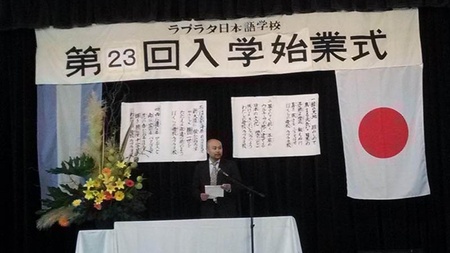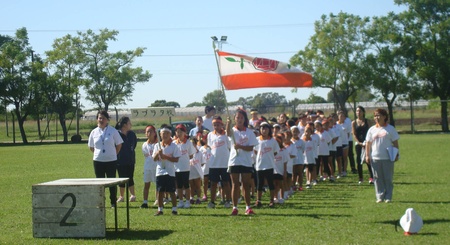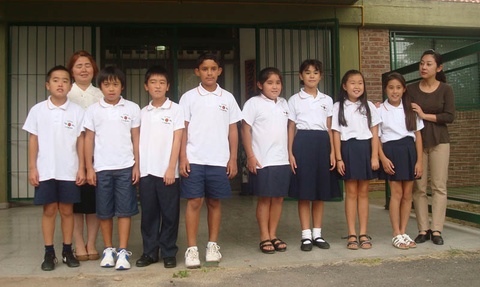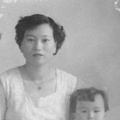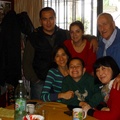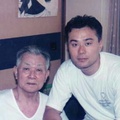1. Japanese La Plata Association.
The Foundation of the Japanese Club of Colonia Urquiza dates back to June 20, 1963, but the headquarters it currently uses dates back to 1972, with a curved roof and wavy zinc walls, with an area of 200 square meters and its interior divided into two classrooms. During these times, financial aid for the education of settler children is strengthened, through JICA, as well as financing for the dissemination of the Japanese language by the Japan Foundation.
Regarding the validity of its legal status, it dates back to 1977 when it was renamed the La Plata Japanese Association (AJLP). Its headquarters were reopened in 1980, and its growth marks the consolidation of education in Japanese.
We can know the number of members of the Colony, from a registry carried out by the Association periodically, which gives us a sample of the number of members, because they include the head of the family and its members (dependent children and parents if they are available). their care, but also those children who have not become independent with their families or not). In it, 104 associated families are established, with a total of 406 individuals (it is calculated between associates and non-associated members that there are more than 136 families, which exceed 500 individuals). The composition of each family emerges from the registry, with typical families (1 or 2 children) prevailing. 1
In 2013, the AJLP turned 50 and celebrated it with a great reception at the institution's club, attended by prominent authorities: the consul, representatives of JICA, and other associations. A tribute was made to the presidents of the association and, through images organized by the youth department, the history of the AJLP was told, how it was organized through the creation of the women's ( fujimbu ) and youth departments. ( seinen-bu ), baseball ( yakyubu ), singing ( uta ), dance ( odori ), gateball ( rojim-bu ), ping pong, which have been consolidated, managing to strengthen the ties of the associates and the community .
2- Japanese School.
For Japanese immigrants who settle in colonies, the first thing is the creation of a school, as a way of preserving the language and as a mechanism of cultural reproduction and communication. The first school operated in a cabin in the countryside of the Ishihara Family, built by Japanese settlers. The Japanese School of Colonia Urquiza was only founded in 1969, and the current establishment was inaugurated in the 1990s. In 1987, five surrounding colonies (El Pato, La Plata, Porteños-Banderitas-Tobu, Santa Mónica) were merged to create a single one that would operate in the Japanese School of Colonia Urquiza, which was renamed the La Plata Japanese School. Nihongo Gakko with the primary demand that families join the AJLP. In 1980, the first teacher with a degree arrived from Japan and from that date onwards, different teachers have traveled from Japan to Argentina to prioritize teaching, and JICA in the first years not only provided teachers, but also materials so that the school.
Currently, the teaching staff is made up of 7 teachers, the majority Nisei 2 . The institution also promotes the comprehensive education of children in terms of values and principles, which allow them to be proud of their Japanese roots ( origami , popular songs and festivals of the Japanese calendar).
Regarding the level, the Institution is recognized as a language trainer, it is important to highlight that in comparison to other similar ones within the country, the Colonia Urquiza school is very well regarded, not only for the continuous work that is developed in pursuit of precise objectives regarding knowledge, but also because there is always a decision to perfect and advance towards the best for the children and young people who are part of it 3 . Furthermore, we must remember that unlike other Institutions, this one is located in rural areas and with a family environment, among which there is a large Issei population that favors and prioritizes cultural transmission.
In order to start studies there, it is necessary to have Japanese blood (Nikkei) for one of the family members, which has been modified in recent years, at the request of the community to accept non-Japanese children (they are a minority), as long as they are presented. by two Japanese families or descendants and who belong to the La Plata Japanese Association.
Ages vary, and so does the frequency with which they attend, for example, students from 6 to 11 years old, do it three times a week for a total of 9 hours, those from 12 to 15 and onwards, do it only once a week. week. Classes are 40 minutes with a 10-minute break during the week; However, on Saturdays they begin with a 45-minute class with a 15-minute break and then go to 40 minutes with a 20-minute break. Before starting the day, physical exercises are performed, radio taiso , which last approximately 10 minutes in the class. sports court. In case of rain, the AJLP club facilities are used. They do not wear a uniform to attend, only on special occasions, such as the beginning and lunch of classes, and in Undoukai (sports party) they use the t-shirt and sweatshirt with the establishment's logo.
When they graduate, they receive recognition for having attended Japanese school. Children of Japanese descent have an easier time acquiring the language if they enter, as in formal education, at age 6. Although you do not obtain a degree, the 6-year diploma completed opens the doors to obtaining a JICA scholarship 4 . If students are 9 years old or older, they can take a Japan Foundation Japanese Language Proficiency Test that has international validity 5 .
As in formal education, children prepare with their teachers celebrations corresponding to Japan such as Hina Matsuri Girl's Day (March 3), Kodomo no hi Children's Day (May 5), Grandfather's Day Keirokai (3rd Sunday in May) in addition to drawing, reading and recitation contests, Tanabata matsuri (bamboo decorating), writing a wish to the stars (July 7) and the Gakugeikai (acting, singing, dancing, recitation) as a closing of the school year. Families actively participate in celebrations such as Undoukai and Bon Odori 6 , perhaps the best-known celebration in the receiving society.
The school has a cooperator made up of the parents of the students, and by paying a monthly fee the necessary resources are obtained to pay the salaries of professors and teachers. At the beginning of the school year, a parents' assembly is held and a commission is appointed that lasts a year until Bon Odori, which takes place during the second week of January and is the time to present the balance sheet and details of everything. carried out, with the suggestions that are considered appropriate, both with regard to the School and the implementation of the events. This commission is the organizer of the year's activities, calling a parent meeting before the beginning of the cycle to explain what the language classes are like, what the extracurricular activities are like, for example sports, public speaking, and also to give each family the planned schedule and the supplies that children must bring on the first day of class. Before school activities begin, families are also called to clean the Institution, which reveals a strong commitment to the cultural formation of their children.
Regarding sports activities, the most important event is the school's internal Undoukai, but there is also the inter-school event, which changes venue each year where the competitions end with the presentation of medals, supplies and trophies for the schools 7 . In addition, table tennis tournaments, composition competitions, public speaking, reading, recitation and Japanese calligraphy, drawing and painting competitions are held both locally and intercollegiately. Outside the school context, children participate in soccer and baseball tournaments organized only for Nikkei.
The testimonies of those who were the first generation of children of immigrants and students of the colony's language school, who later continued tertiary and university studies inside and outside the country, recognize the training that since first grade and in parallel to formal education received at the Japanese School. Many of them also highlight that from home, their parents dedicated themselves to speaking to them in Japanese practically from birth, as a way of strengthening communication and helping to neutralize identity dispossession , typical of emigration, but that at school they learned to read and write. Others mention that it took a short time, some even learning Hiragana, but again they highlight that with the help of the family, reading mangas or watching videos of Japanese programs or other material that came from Japan, they could complete basic training.
Grades:
1. Census carried out at the local level to know the members of the Japanese Association of La Plata, September 2002. In turn, every year, in the month of August, the AJLP board of directors registers in the balance sheet, the number of partners, accounting for heads of family.
2. This information was provided by the current Director Ikuyo Miyawaki, whom we thank for her invaluable collaboration.
3. It is also true that with each new generation interest decreases.
4. Young people between 13 and 15 years old can obtain a month-long training scholarship in Japan granted by JICA, but there are also others, such as, for example, a 10-day internship at a school in Japan for descendants of immigrants who It is awarded at age 11 by the Prefectures. This last form requires knowledge of the language on the part of the child, a tutor to accompany him on the trip and intense activity on the part of parents and grandparents within the community precisely in the Kenjinkai (group of provincials) that holds a once a month. There are also Monbusho scholarships (Ministry of Education, Science and Culture of Japan) for students who have completed secondary, tertiary or university studies, in which one of the tests is precisely the Japanese language, in addition to English and may vary in time from 1 to 3 years.
5. The international language proficiency exam is taken in December of each year at the University of Belgrano, but at the national level there is also the Tokimeki exam.
6. It is a popular religious dance that originated to give comfort to the spirit of the deceased during the time of Obon (July 15 according to the lunar calendar or August 15 according to the solar calendar called the Lantern Festival in the Buddhist tradition) and is usually danced by both men and women and even children. They dance around a tower erected especially for the occasion. In countries in the southern hemisphere it is celebrated in January or February to the rhythm of taikos (Japanese drums) and under the glow of fireworks that are characteristic of the celebration in Colonia Urquiza.
7. In 2010, the La Plata Japanese School team won the Challenger Cup for winning the intercollegiate Undoukai three consecutive times, which is proudly displayed in a showcase of the Institution. In 2011 they also had a great performance, emerging victorious, and from 2012 to 2014 the performance of the students in general is very satisfactory.
* “Some voices, a lot of tradition” Past and present of the Japanese Community of Colonia Justo José de Urquiza. By Irene Isabel Cafiero and Estela Cerono. First edition. Al Margin Editions. The Silver. 2013. ISBN 978-987-618-163-1.
© 2014 Irene Isabel Cafiero


